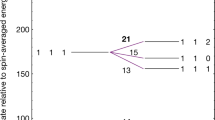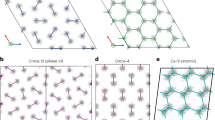Abstract
Since the suggestion that hydrogen ion clusters of the type H+n may be present in gaseous nebulae1,2 and interstellar space3,4 and the early experiments of Clampitt and Gowland5, who discovered such clusters for 3≤n (odd) ≤99 in low temperature (3K) mass spectrometer experiments, it has sometimes been assumed that only odd-numbered clusters exist (ref. 6, and refs therein). There have been extensive studies in the past decade on the binding energy and the geometry of these ion-induced-dipole clusters. Massa et al.7 have carried out ab initio calculations on H+n, for odd values of n ranging from 3 to 15. Weak binding energies of the order of 44meV against dissociation according to H+n→H+n−2+H2 5 ≤ n (odd) ≤ 15 were found. The geometrical shape of these clusters was calculated to be dominated by a triangular nucleating centre H+3 with the relatively high proton binding energy of 4 eV. Salmon and Poshusta8 have conducted polarised-orbital valence-bond calculations on the ground state properties of H+5. Most recently, the molecular structure of H+3 has been experimentally determined by means of the beam-foil technique9. We describe here an ion-trap experiment in which we studied collisional processes of electrons with hydrogenic trapped ions of mass numbers, 1, 2, 3, 5, 7, 10, 14, and 20. Since these are the only ions observed, up to a mass limit of 40 AMU, there are serious implications for the assumption by some theoretical chemists that H+n; exists only for odd values of n.
This is a preview of subscription content, access via your institution
Access options
Subscribe to this journal
Receive 51 print issues and online access
$199.00 per year
only $3.90 per issue
Buy this article
- Purchase on Springer Link
- Instant access to full article PDF
Prices may be subject to local taxes which are calculated during checkout
Similar content being viewed by others
References
Krasovskii, V. I. Sov. Astr. 2, 715 (1958).
Donn, B. Astrophys. J. 132, 507 (1960).
Hoyle, F., Wickramasinghe, N. C. & Reddish, V. C. Nature 218, 112 (1968).
Wickramasinghe, N. C. & Reddish, V. C. Nature 218, 661 (1968).
Clampitt, R. & Gowland, L. Nature 223, 815 (1969).
Sapse, A. M., Rayez-Meaume, M. T., Rayez, J. C. & Massa, L. J. Nature 278, 332 (1979).
Harrison, S. W., Massa, L. J. & Solomon, P. Nature phys. Sci. 245, 31 (1973).
Salmon, W. T. & Poshusta, R. D. J. chem. Phys. 59, 4867 (1973).
Gaillard, M. J. et al. Phys. Rev. A 17, 1797 (1978).
Hasted, J. B. & Awad, G. L. J. Phys. B5, 1719 (1972).
Hamdan, M., Birkinshaw, K. & Hasted, J. B. J. Phys. B 11, 331 (1978).
Mathur, D., Khan, S. U. & Hasted, J. B. J. Phys. B11, 3615 (1978).
Mathur, D., Hasted, J. B. & Khan, S. U. J. Phys. B12, 7921 (1979).
Author information
Authors and Affiliations
Rights and permissions
About this article
Cite this article
MATHUR, D., HASTED, J. Odd and even numbered hydrogen ion clusters. Nature 280, 573–574 (1979). https://doi.org/10.1038/280573a0
Received:
Accepted:
Published:
Issue Date:
DOI: https://doi.org/10.1038/280573a0
Comments
By submitting a comment you agree to abide by our Terms and Community Guidelines. If you find something abusive or that does not comply with our terms or guidelines please flag it as inappropriate.



